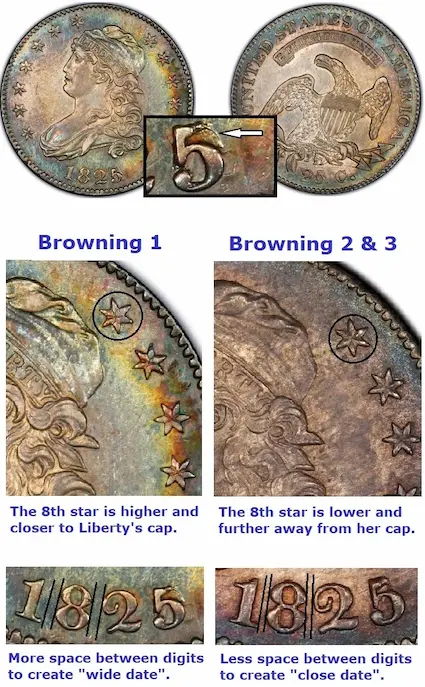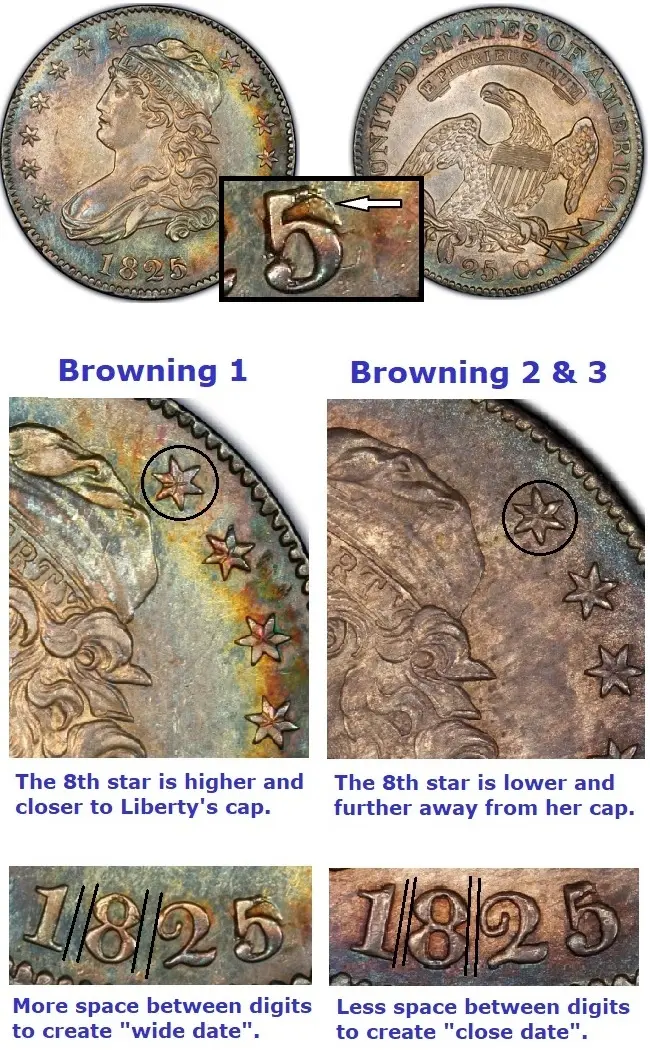1825 Capped Head Quarter, 5/4/2, Browning-1
All 1825 Capped Bust quarters were struck from three die marriages, which paired two obverses with three reverses.(1)
Furthermore, 1825 quarters are all overdates: that is, the “5” digit was punched over a previously existing digit (or digits -- plural). Until fairly recently, numismatists have debated since 1884 over the identity of the overdated digit(s).(2)
Researcher Steve Tompkins settled this dispute in 2008 with publication of his Early United States Quarters 1796-1838. Tompkins convincingly reasoned both 1825 obverse dies are leftovers from 1822 and 1824, and both are correctly described as 1825/4/2 overdates.(3)
Let’s break down the sequence of events leading to this conclusion:
- Five obverse dies were manufactured in 1822. Remember, because their design elements were generated manually, there are subtle, identifiable differences between all five dies.
- Only one of these was needed to strike quarters for 1822, leaving four of them unused.
- One of the four unused 1822 dies was overdated with a “3” to strike 1823/2 quarters, leaving three unused 1822 dies.
- The three remaining unused dies were all overdated with a “4” to strike 1824/2 quarters. However only one die was needed to meet the small quantity of quarters ordered by the Mint’s silver depositors in 1824.
- This left two unused 1824/2 obverse dies, which were soon overdated again, with a “5” punched on top of the 4 (which was already punched over a 2) for striking 1825/4/2 quarters.
As mentioned, all 1825 quarters were struck from one of three die marriages, often called die varieties. Numismatists have named these varieties as B-1, B-2, and B-3. The “B” is for A.W. Browning, who catalogued many quarter die varieties in his classic book The Early Quarter Dollars of the United States, 1796-1838, first published in 1925.(4)
Recognizing the difference between the 1825 die varieties is crucial, because of their varying availability and value. Here is how they rate:(5)
- Browning 1 - Rare
- Browning 2 - Fairly Common
- Browning 3 - Scarce
The rarest of the three by far, the B-1, can be attributed easily. The obverse die on the B-1 places star #8 higher and has a wider date. On B-2 and B-3, star #8 is lower and the date is closer (i.e., narrower).
PCGS estimates there are 237 of the 1825/4/2 quarters, of which only a small percentage of them are the B-1 variety.
The trend charts on Rare Coins 101 depict price movements for the 1825 Browning-1 variety. Its value performance far exceeds those of the B-2 and B-3. If this fascinating overdate interests you, be sure to focus on the B-1 variety, if long term price appreciation is your goal.
| Estimated survivors in all grades: 237 ?
The survivor estimate from PCGS represents an average of one or more experts' opinions as to how many examples survive of a particular coin in all grades. Survival estimates include coins that are raw, certified by PCGS, and certified by other grading services. Learn more at PCGS. |
| PCGS Rarity Scale: 6.7 ?
The 'PCGS CoinFacts Rarity Scale' assesses the relative rarity of all U.S. coins, based on estimated surviving examples. The scale runs from 1.0 to 10.0. The higher the number, the rarer the coin.
Learn more at PCGS. |
| Search for the 1825 Capped Head Quarter, 5/4/2** |
Preview of eBay selection (the B-1 variety of the 1825 25C is very difficult to find):
 |
|
| Trendline Avg = 22.99 | BETTER |
 |
|
| Trendline Avg = 22.99 | BETTER |
Historic Value Trend Charts:
| Last updated 4-8-25 | Return to Key Date Coin List | |
| Compare to Common Date Coin of Same Type | ||
|
|
||
| Download Charts to Your Computer | ||
Sources
1. PCGS. 1825/4/2 25C (Regular Strike).
2. Stack's Bowers Galleries. 1825/4/2 Capped Bust Quarter. May 2015 Auction.
3. PCGS. 1825/4/2 25C (Regular Strike).
4. NGC. Early Quarters (1796-1838).
5. PCGS. 1825/4/2 25C (Regular Strike).
**Many very fine coin dealers sell on eBay. At any point in time, there may be over one million search results for United States coins. This includes quite a few of the recommendations on our Key Date Coin List.
If you’re thinking about purchasing a rare coin, eBay is certainly worth a look. For your convenience, the links from this site to eBay are coded to bring up only coins certified by PCGS and NGC.
As is always, always the case, never buy a valuable coin from a seller whose trustworthiness cannot be verified. Learn more about this at our chapter Best Places to Buy Coins, which also has a section on doing business on eBay.
In the interest of full disclosure, Rare Coins 101 receives a small commission anytime someone connects to eBay from this site and purchases something.
Coin images by PCGS.


